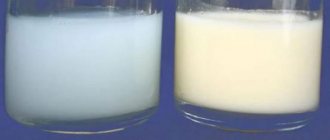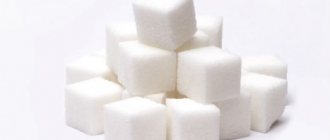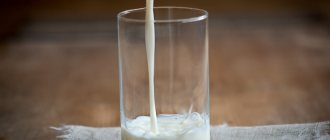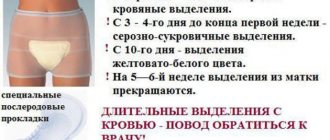Nutritional value of breast milk
The composition of mature breast milk includes: water - 87%, carbohydrates - 7%, fats - 4%, proteins - 1% and other substances (vitamins, minerals, hormones, etc.) - 1%. The ratio of some of these components changes during feeding. The detailed composition of a woman’s breast milk is discussed in an article on our website.
It is worth noting that the fat content and, accordingly, the suspension of solids in hind milk is indeed several times higher than the consistency of fore milk. The ratio of all components of nutrients (proteins, carbohydrates) in milk for the full feeding period is practically unchanged. Despite the fact that this fact has been confirmed from a scientific point of view, there is a misconception that the front portion of milk contains much more protein and lactose.
Lactose is a natural sugar found in milk, which plays a significant role in the development of a child, especially his nervous system. It also helps fill all parts of the intestines with healthy microflora, thereby taking part in the formation of the baby’s immune system. If primary milk does not enter the baby’s stomach, then he will lose a portion of useful components that are simply necessary at his age.
Proteins in mature breast milk are represented by casein and whey fractions. Casein proteins are produced in the breast itself, while whey proteins come from the mother's bloodstream.
When breastfeeding, it is very important to have a balanced milk intake, consisting of both front and rear milk. At the same time, the volume of breast milk consumed should be regulated directly by the child. It is impossible to establish a clear line where the foremilk stops and the hindmilk begins. Let's define foremilk and hindmilk.
Foremilk and hindmilk and the consequences of its “imbalance.”
What happens after such a diagnosis is made? The doctor, suspecting lactase deficiency, strongly recommends that the mother and her child postpone breastfeeding until better times, and sometimes even switch to artificial formulas, which are more “safe” and “healthier” for the child, unlike breast milk - nutrition, down to the last detail thought out by nature itself. To avoid getting into a situation where supermarket formula becomes the baby’s main diet, you should know the peculiarities of breastfeeding, as well as fore and hind breast milk.
Every time a mother puts her baby to her breast, she should remember that:
- For active sucking, the child must completely grasp not only the nipple, but also the areola with his mouth, while the mother must be able to hear him swallowing milk;
- Alternately placing the baby on the left and right breasts during one feeding can leave him without hind milk, while fore milk and the lactase it contains will enter the body in excess;
- Pumping stimulates the production of foremilk rather than hindmilk;
- Breastfeeding a child by the hour was invented for the convenience of working women in the last century, but not for the benefit or health of the baby;
- Night feedings can normalize lactation and equalize front and rear breast milk.
Breastfeeding is something truly worth fighting for. And all issues related to the formation of lactation, breastfeeding for more than a year, as well as front and rear breast milk are best resolved together with an experienced lactation consultant.
By understanding what foremilk and hindmilk look like, mothers will be able to better control the feeding process and maintain the baby’s nutritional balance.
What is hindmilk
The baby receives hind or late milk in larger quantities at the end of feeding, and the more empty the breast is, the fattier the milk. Hind milk is a rich milky liquid with a high fat content. Increasing the concentration of fats regulates the child's satiety and protects him from overeating. Enzymes contained in hind milk promote the absorption of fore milk.
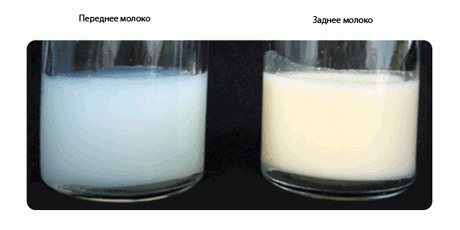
Reasons for the division of breast milk into fore and hind
In fact, a nursing woman’s body produces breast milk of the same composition and fat content. Conditional separation occurs due to the fact that during the period of accumulation of milk in the glands, its stratification occurs, which indicates a different location of the molecules of its components. Fat molecules stick together and stick to the walls of the alveoli. As milk is produced, other components rush from the alveoli towards the nipple, and fats remain stuck to the walls of the milk ducts. If the breast expands and milk itself begins to drip from the nipple, then this milk contains a minimum concentration of fat.
There is a good analogy with a hot water tap. When you turn on the hot water tap in the morning, cold water runs first, and gradually it becomes warmer and warmer and at some point it becomes hot. So with mature milk, the transition from front to back is gradual, in addition, there are cycles, when suddenly the water either becomes cold, then suddenly very hot. Conventionally, feeding can be divided into several cycles, that is, during one feeding the baby can move from foremilk to hindmilk and vice versa. In the initial cycles, the baby receives mostly foremilk, and in the latter cycles, hindmilk. Mothers feel the change of cycles with a slight tingling sensation in the chest.
In order for the baby to receive hindmilk in sufficient quantities, it must be applied several times to one half-empty breast.
How to make breast milk fatter
Scientists have proven that the diet of a nursing mother does not significantly affect the concentration of fat in milk. A balanced diet during the lactation postpartum period plays an important role, but first of all directly for the woman herself. Changes in fat content occur as a result of the frequency of feeding during the day.
Morning milk is the wateriest and contains the least fat. And also milk during a long absence of feeding, when a woman feels bloated, and when milk itself begins to be released from the breast.
Milk is considered to be the richest in semi-empty glands. Therefore, you should not worry that by the evening the amount of milk will not allow the baby to be fully satisfied. In fact, in this case, the baby will be satisfied not with the volume, but with the fat content of mother’s milk, after which he will fall asleep satisfied and well-fed. The main thing in this situation is not to use artificial formula supplementation during breastfeeding.
In the event of a forcible interruption of the feeding process, or a change of mammary glands, there is a high probability that the child will not get enough. Instead of the back portion of milk, he will feed again on the first one. Leave the right of choice in this case to the baby, he will figure out what he wants more now.
Breast milk can be made fatter only by expressing, but this is not an option; the child is able to control his own satiety. And if there is a lot of foremilk, he will simply suckle longer and repeated feeding must be started from the same breast.

How to properly breastfeed your baby so that he gets full
When, what kind and how many times should a child be breastfed so that he receives all the nutrients he needs - frequently asked questions. Let's answer them in detail. Each child is an individual child’s body, which is characterized by its own feeling of satiety. Some babies eat often, but in small portions, while others can eat for a very long time with breaks to play near their mother’s breast. The beneficial substances that make up mature breast milk are needed by the baby in the quantities in which the mother’s body produces them. Their receipt and assimilation depends on the quality of attachment, the frequency of breast changes and the duration of sucking.
Proper latching of the baby to the breast
When properly attached to the breast, the baby receives sufficient amounts of fore and hind milk. If the nipple is not grasped correctly during feeding, the settled fat molecules will not be separated and the baby will not receive enough fatty milk, but will feed mainly on the front milk. The mother definitely needs to master the correct technique for attaching to the breast, and even in the maternity hospital, teach the baby to properly latch onto the nipple.
Rules for alternating breasts
During daytime feeding on demand, you need to make sure that for 2 hours only one breast is offered to the baby, and then you can switch to the other when the first one is completely emptied. The baby must completely empty the breast, then he will receive all the nutrients he needs in sufficient quantities. If during feeding the baby is capricious and eats little, then he should be offered the same breast after 15-20 minutes.
How long should a baby nurse?
The baby sucks out the fatty hind milk slowly, literally drop by drop; it is released through prolonged sucking and, as a rule, at night. In addition, hind milk causes drowsiness. It usually looks like this: the baby is sleeping and lightly sucking on the breast, there is no need to tear it off; when he is full, he will let go of it himself. If the mother stops feeding while the baby is sucking sluggishly, he will not receive enough fat and will not gain weight well. The weight gain table can be found on our website.
How to feed your baby
Foremilk and hindmilk - how to properly feed the baby so that he is full and receives all the necessary substances? Does baby need a lower fat front drink?
You need to remember the basic rule - the more often the baby is put to the breast, the more uniform nutrition he receives. In this case, there is no special transition between the foremilk and hindmilk; it is uniformly fatty and nutritious. If feeding periods are more rare - once every 2-2.5 hours, fat content will increase as feeding occurs.
The more your baby empties, the more fatty hindmilk he will receive at the end of the feeding.
That is why it is very important to ensure that the baby sucks completely from the breast. Otherwise, hindmilk may simply not reach the baby.
Hind milk and front milk should be well absorbed by the baby. In order for your baby to get the maximum benefit from breastfeeding, you should follow simple recommendations.
Correct application
If the nipple is not latched on correctly, the baby runs the risk of not receiving nutritious hindmilk. It is imperative to master proper attachment in order to begin feeding your baby fully while still in the maternity hospital.

We feed at night
Night feedings. Stimulates milk production, including hind milk. For mothers whose children sleep all night without waking up to feed, milk disappears much faster and more often. Hind milk “lulls” the baby to sleep, after which the baby wants to sleep. If a baby falls asleep with the nipple in his mouth and periodically sucks on it in “sleep mode,” you should not take the breast away from him. Otherwise, he may not get enough hindmilk. A well-fed baby will let go of the breast on its own and continue to sleep.
Mixtures – no solids
Refusal of mixtures. Additional supplementary feeding can negate all the mother’s attempts to establish guard. If it seems that there is not enough milk, you need to offer the breast to your baby more often. It's okay if your baby hangs on your chest for hours. Over time, the saturation process will occur faster. The main thing is not to aggravate the situation by introducing mixtures without medical indications.
The occurrence of an imbalance of foremilk and hindmilk
With hyperlactation (increased milk production), the child consumes only the first milk, which is quite liquid in consistency and contains a minimum of fat. This contributes to its rapid movement through the digestive tract, which does not allow it to be properly digested.
In order for lactose to be digested, lactase is required, but when food moves quickly, it does not have time to break down milk sugar. As a result, the fermentation process begins in the intestines, creating a strong discomfort for the child. This pathology is called lactase deficiency.
Symptoms of lactase deficiency
- Restless behavior while eating
— Fecal masses are liquid and foamy in structure
— Flatulence
— Small weight gain
- Frequent regurgitation.
It is not recommended to give up breastfeeding. With proper behavior, lactation quickly normalizes to the child’s needs. To do this, you should increase the frequency of placing the baby on one breast and, if possible, refrain from pumping. It is better to sleep with the baby so that he always has access to the breast. You should try to reduce pumping by a few milliliters per day. If a child suffers from gas cramps and intestinal colic, he can be given Espumisan in syrup immediately before breastfeeding. You should not switch to mixed feeding, especially artificial feeding.
The only indicator for stopping breastfeeding is the presence of congenital lactase deficiency in a newborn baby. Such children are allowed to be fed exclusively with dairy-free artificial formulas prescribed by the pediatrician after diagnosing this pathology. And lactase deficiency should be present not only in the tests, but also in the clinical picture.
Milk imbalance
A common occurrence during breastfeeding is an imbalance of foremilk and hindmilk, its symptoms are as follows:
- restlessness while eating;
- the baby's stool is liquid and foamy in consistency;
- bloating, gas;
- frequent regurgitation after eating;
- underweight.
In this case, there is no need to give up breastfeeding. The best solution is to provide your baby with constant access to the breast and, if possible, refrain from pumping. And also follow all the points of “correct” breastfeeding listed above. Over time, lactation will improve, and digestive difficulties will go away on their own.
If the symptoms do not disappear, then they may be caused by lactase deficiency. It occurs due to undigested lactose. Foremilk, which contains no fat, moves very quickly through the digestive tract. As a result, the milk is not completely digested, creating tummy problems. This situation can be corrected. You need to contact your pediatrician, he will prescribe special enzymes and other medications. The introduction of lactose-free mixtures may be required only as a last resort. In most situations you can do without them.

